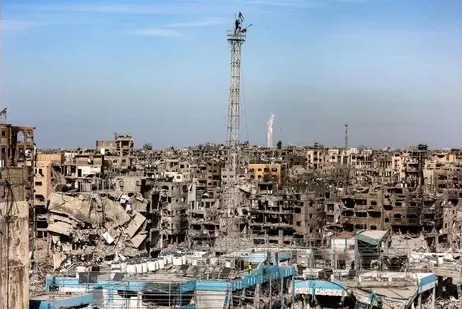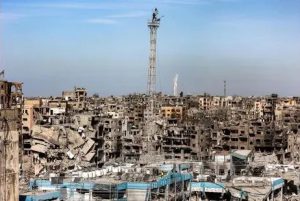After fifteen months of devastating conflict, Israel and Hamas have reached a ceasefire deal that aims to stop violence in Gaza and facilitate the release of hostages. The agreement, brokered by Qatar, Egypt, and the United States, marks a significant turning point in the long-standing Israeli-Palestinian conflict and raises hopes for lasting peace in the Middle East.
The Israeli cabinet approved the deal on January 18th, with 24 out of 33 ministers voting in favour. It took effect on Sunday, January 19th, the day before Donald Trump’s inauguration as the 47th U.S. President.
The deal is structured in three phases, each lasting approximately six weeks. The first phase involves the release of 33 Israeli hostages by Hamas, including women, children, and the elderly, in exchange for about 1,650 Palestinian prisoners. Israeli forces will withdraw from populated areas in Gaza, pulling back to a kilometre-long buffer zone along the border. The Rafah crossing with Egypt will open seven days after the start of the first phase, allowing for a significant increase in humanitarian aid, with up to 600 trucks entering daily. Subsequent phases aim to address the release of remaining hostages, further Israeli troop withdrawals from Gaza, and the initiation of reconstruction efforts in Gaza.
The ceasefire aims to halt the ongoing violence that has resulted in nearly 47,000 casualties and near-total destruction of Gaza. The truce with Hamas is expected to extend Israel’s existing ceasefire with Hezbollah in Lebanon, thereby reducing immediate tensions in its neighbourhood and avoiding the risk of a broader regional conflict. This de-escalation could create a more stable environment for diplomatic initiatives and regional economic cooperation.
Trump described the deal as an “epic ceasefire agreement” and vowed to continue working closely with Israel and other allies to ensure Gaza does not become a “terrorist safe haven” He pledged to promote “Peace Through Strength” throughout the region, invoking a foreign policy doctrine that emphasises the belief that a strong military presence can prevent conflicts from escalating. The ceasefire presents an opportunity for the U.S. to reassert its diplomatic role in the region; however, achieving this requires a careful balance between supporting Israel and addressing the legitimate grievances of the Palestinians.
The agreement highlights the evolving dynamics among key regional players. Qatar’s role as a primary mediator has further elevated its diplomatic standing. Egypt’s regional stature has also been enhanced following its successful involvement in brokering the deal, reinforcing its historic role as a key mediator between Israel and Palestinian factions.
The ceasefire may help revive discussions to expand the Abraham Accords further by pursuing a potential Saudi-Israeli rapprochement. While Riyadh has expressed interest in forging diplomatic relations with Israel, the Palestinian issue remains a sticking issue. The Kingdom now insists on a clear roadmap for establishing a Palestinian state before entering talks to normalise ties with Israel.
For Israel, the ceasefire offers a respite from international criticism and an opportunity to address domestic concerns, particularly the return of hostages. PM Netanyahu’s political survival is at stake as he faces significant challenges, as far-right coalition members oppose the deal. The agreement’s implementation has long-term implications for Israel’s security and will be crucial in shaping its domestic political landscape and regional standing.
For Hamas, the ceasefire provides a breather, allowing it an opportunity to regroup and consolidate its support among the Palestinians and even claim a symbolic victory as it was able to survive Israel’s onslaught and secure the release of Palestinian prisoners.
Iran, a major supporter of Hamas, has portrayed the ceasefire as a “victory” for the Palestinian resistance. Tehran’s recent setbacks in Lebanon, Syria, and Gaza have left it isolated with diminished regional influence. The country is also concerned about its future relations with the United States under the Trump administration.
While the proposed ceasefire deal represents a significant milestone in the tumultuous history of the Middle East, considerable challenges to its implementation remain, particularly in the later phases, which render it vulnerable to collapse.
For example, it does not address the future governance of Gaza. Will Hamas be allowed to assume a political role again? During last week’s meeting of the Global Alliance for the Implementation of the Two-State Solution held in Oslo, Palestine’s Prime Minister Mohammad Mustafa rejected a proposal discussed by the United States, the UAE, and Israel for an international post-war administration in Gaza, led by a senior UN official. He emphasised that the Palestinian Authority (PA) must be the sole governing body in Gaza following the ceasefire. Ironically, Netanyahu has consistently opposed the PA’s return to Gaza since the 2007 conflict between Hamas and Fatah, which effectively removed the PA from the Gaza Strip.
The reconstruction of Gaza will be a monumental task. According to UN data, 70% of concrete structures in Gaza have been severely damaged or destroyed, including over 245,000 homes, which has transformed the area into a wasteland. Restoring healthcare facilities in Gaza and providing nutritious food to more than 1.8 million Palestinians facing “extremely critical” levels of hunger is a top priority. Rebuilding Gaza will require substantial funding, estimated at US$100 billion, and several years of dedicated effort. Israel should be discouraged from pursuing its threat to ban the United Nations Relief and Works Agency for Palestine Refugees in the Near East (UNRWA), as this would severely impede the distribution of aid to the Palestinians at this critical juncture.
To translate the temporary truce offered by the ceasefire deal into lasting peace and stability in the region, sustained international engagement and goodwill from all parties, especially the United States and other guarantors, will be essential. The fundamental issue at the heart of the conflict—the establishment of an independent state of Palestine coexisting with Israel—must be addressed with sincerity and pragmatism.
****
(This article was published in the Op-Ed page of Hindustan Times of January 21, 2025)

